 Leading Blog | Posts by Month |
 Leading Blog | Posts by Month |
01.31.11

LeadershipNow 140: January 2011 Compilation
Posted by Michael McKinney at 07:29 AM
01.30.11

Hay Group's 2010 Best Companies for Leadership Hay Group, a global management consulting firm, released its 2010 Best Companies for Leadership Study and Top 20 list. The study ranks the best companies for leadership around the globe and examines how those companies develop current and future leaders. 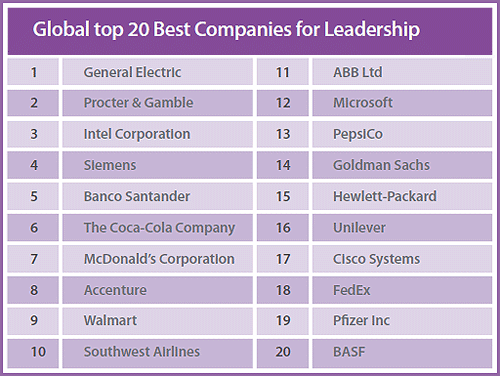 According to Hay Group’s study, all of the Top 20 companies report that everyone at every level of the organization has the opportunity to develop and practice the capabilities needed to lead others, compared to less than 70 percent of all other companies in the study. In addition, 90 percent of the Top 20 companies report that people are expected to lead regardless of whether they have a formal position of authority, compared to only 59 percent of other companies. “The Top 20 Best Companies for Leadership are at the forefront of a significant shift away from hierarchical organizational operating models,” said Rick Lash, Director in Hay Group's Leadership and Talent Practice and co-leader of the Best Companies for Leadership Study. “Leadership in the twenty-first century is about leading at all levels; not restricting it to title. As organizations become flatter, the best leaders are learning they must check their egos at the door and become increasingly sensitive to diversity, generational and geographical issues.” 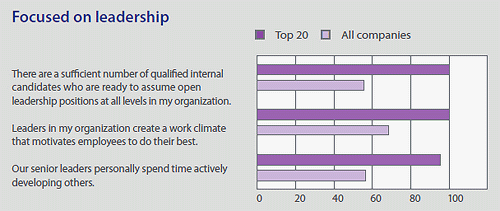 They found that the best companies are moving more quickly and completely than other companies to flatten their structures and prepare their managers to lead effectively within it. Specifically they drive collaboration and cross-functional leadership and innovation, actively seek greater cultural diversity in their leaders and workforces, and they show a strong focus on developing leaders within their organizations. In the process, they are gaining important competitive advantages. Related Interest:
Posted by Michael McKinney at 11:36 AM
01.28.11

10 Ways to Make Others Shine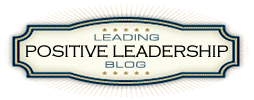 Earl Miller, a neuroscientist at MIT says, “Success has a much greater influence on the brain than failure.” Ned Hallowell comments in Shine: While of course mistakes need to be acknowledged and, one hopes, learned from, it may be more likely, from a purely neurological point of view, that a person will learn more from a success than a failure.” Earl Miller, a neuroscientist at MIT says, “Success has a much greater influence on the brain than failure.” Ned Hallowell comments in Shine: While of course mistakes need to be acknowledged and, one hopes, learned from, it may be more likely, from a purely neurological point of view, that a person will learn more from a success than a failure.”
Hallowell points out that acknowledgment or recognition serves two important functions. Of course there is the familiar purpose of giving the recipient encouragement, motivation and greater confidence, but recognition also promotes moral behavior through connection. Hallowell explains: “When a person feels recognized and connected to the larger group, she knows viscerally, not just intellectually, that she has made a contribution others value. Not only does this motivate her to do more and try harder, but it instills a desire to look out for the larger group…. It leads a person to do the right thing even when no one is looking.” Showing appreciation and giving recognition is part of the Cycle of Excellence process he calls shine. In our busy culture it is easy to overlook opportunities to acknowledge others. Noticing the positive is a daily challenge. In Shine, Hallowell offers these ten tips for promoting shine with the people you influence:
How do you make others feel valued? Related Interest:
Posted by Michael McKinney at 12:06 PM
01.27.11

The Cycle of Excellence: 5 Steps to Peak PerformancePsychiatrist Edward Hallowell says that to bring out the best in people you have to focus on the interaction between what is within a person and what lies outside. Properly aligned, you can achieve peak performance. By peak performance he means “consistent excellence with improvement over time at a specific task or set of tasks.” “While no one has ever achieved the goal of ‘being all they can be,’” he says “everyone has it in them to deliver peak performance defined in that way.”In Shine: Using Brain Science to Get the Best from Your People, Hallowell, combines brain science and performance research to help you get the most out of people’s brains (including your own). To ignite peak performance, he has created a process called the Cycle of Excellence. It is a five step process, that when followed completely, leads to excellence. The steps are:
Unfortunately the modern world works against us. Hallowell has identified two paradoxes of modern life. First, “While we have grown electronically superconnected, we have simultaneously grown emotionally disconnected from each other.” Disconnection short-circuits the Cycle of Excellence more quickly than anything else. “Disconnection is one of the chief causes of substandard work in the modern workplace. But it is one of the most easily corrected.” The second paradox is that “people’s best efforts often fail not because they aren’t working hard enough, but because they are working too hard.” Overwhelmed with data, we try to compensate by working harder trying to process more data. What we should be doing is erecting boundaries to regulate what we allow in. Leaders need to be helping people to regulate their lives and manage technology rather than pushing them to do more. Greater connection and engagement will result. 
Posted by Michael McKinney at 11:50 PM
01.25.11

5 Leadership Lessons: Five Lessons from Hank Moore In The Business Tree: Growth Strategies and Tactics for Surviving and Thriving, corporate strategist and author Hank Moore shares some of the lessons he has learned over the years. Here are five: Moore suggests that you keep your own diary of lessons learned—both reasons for your successes and your failures. What could you add to this list? 
Posted by Michael McKinney at 06:07 PM
01.21.11

How to Use Social Media to Drive Social Change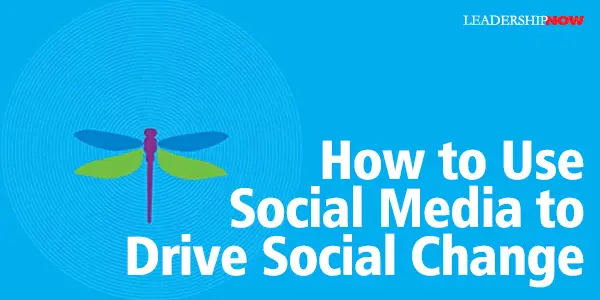
SOCIAL MEDIA. Nobody really understands it, but we know it’s important. How can we use it to influence others? How can we use it to do some good? The Dragonfly Effect by Jennifer Aaker and Andy Smith, is a playbook on how to use social media to achieve a single, focused, concrete goal.
Focus: Identify a single concrete and measurable goal. Goals must be humanistic or based on an understanding of your audience, actionable, testable, clear and meaningful. Striking the right balance between visionary and realistic goals is key to maintaining focus….To achieve balance, break the goal down into parts: a single long-term macro goal and a number of short-term process goals, or micro goals. Grab Attention: Make someone look. Cut through the noise of social media with something personal, unexpected, visceral, and visual. What is the most important message you want to leave your audience with—and why should they care? Engage: Create a personal connection, accessing higher emotions through deep empathy, authenticity, and telling a story. Engaging is about empowering the audience to care enough to want to do something themselves. Engage is arguably the most challenging of the four wings, because love occurs infrequently, and engaging others is more of an art than a science….If you can’t engage them emotionally, they won’t be swayed. Take Action: Enable and empower others to take action. To make action easy, you must prototype, deploy, and continuously tweak tools, templates, and programs designed to move audience members from being customers to becoming team members—in other words, furthering the cause and the change beyond themselves. What you’re asking people to do must be easy, fun, tailored and open. What you are asking of people must be highly focused, absolutely specific, and oriented to action, so as to avoid overwhelming your audience. The Dragonfly Effect is a good model to show how technology can support real-world missions. The Dragonfly Effect shouldn’t be thought of as just a social media framework; the specific and practical principles behind the model will not only help you make an impact through social media but in the real world too. The Dragonfly Effect Model Review:

Posted by Michael McKinney at 06:53 AM
01.19.11

The Secret of the Great Workplace
WHAT LEADER wouldn’t want to lead a “great workplace?” I’ve never run across anyone that wouldn’t. So why aren’t we able to point to more of them? I suspect that, in the main, it’s because many of those leaders that don’t lead great workplaces, don’t know they aren’t. They have never taken the time to ask. From their point of view it’s hard to imagine what they could be doing differently. But, it is those you lead that determine whether or not working with you constitutes a great workplace. Even if you are not the CEO, you can create a great workplace around you. To begin, you need to ask, “What is it like being lead by me?” You make the difference. In The Great Workplace, authors Michael Burchell and Jennifer Robin write, “you need to do your job realizing that how you do what you do makes a world of difference to employees.” The secret of great workplaces is relationships. Relationships between employees and their leaders, between employees and their jobs, and between employees and each other are the three indicators of a great place to work. “If leaders implemented practices and created programs and policies that contributed to these three relationships, employees had a great workplace experience.” The important part is that whatever they did, it had to be done in a way that strengthened relationships.When the authors asked, “Why is your organization a great place to work?” a consistent model emerged. (See below.) The employees said “they believe their leaders to be credible, respectful, and fair—they trust them. They also take pride in what they do, and they share a sense of camaraderie with their coworkers.” Because the relationships you create matter, you're the critical difference between a very good company and a very great company. In the best companies, leaders at all levels have a strong commitment to creating strong ties between the employee and the organization. Indeed, enhancing trust, pride, and camaraderie in the workplace is the central task of effective leadership in today’s organizations. They suggest that what holds leaders back from doing something about this is not having the faith that there are bottom-line results from doing the right thing. Another excuse is no time. Lack of situational awareness and the belief that they should just be focusing on the business also keep leaders from focusing on the relationships that really underlie everything they do.
After building a rational business case for the need to create great workplaces, the authors get into detailing each aspect of the model. It is thorough enough to give you a clear way forward in creating a great workplace in your own situation. With anecdotes, best practices, and quotes from employees working at the best workplaces in the U.S., they give the great workplace a tangible shape. At Analytical Graphics, the president compiles a weekly log of individual, team, and organizational accomplishments he hears about, witnesses, or comes across during the week, and he shares those every Friday at the weekly company lunch (yes, all 275+ employees come together for lunch and a short meeting). Whether it is an item he pulled from the local newspaper about an employee’s efforts in the community, or a milestone that a team passed in developing a product, or how teammates pulled together to help one another out on a particular issue, he makes this a consistent practice. And employees feed off this energy. “Friday afternoon,” one employee commented to us, “is always a high. What a great way to start the weekend, and make me excited to come back on Monday morning.” Does your feedback make your people want to come back and do it again? Do you even give timely feedback? >They encourage leaders not to create something completely new and different, but instead to improve upon what you are already doing. Best practices referred to in the book serve to illustrate ways trust, pride and camaraderie might be built in your own situation, but they are culture-specific. Things get in the way of letting people be human. Particularly quarterly reports and business schools. I think what we try to do is make it very clear that what’s important is doing the right thing. And if we do the right thing, all the other things take care of themselves.” The Great Place to Work Institute has found that great workplaces exist regardless of size, industry, or location because the Model is based on universal “needs and values—trust of the people you work for, pride in what you do, and enjoyment of the people you work with.” The Great Workplace Institute is worth a visit for additional resources and information. 
Posted by Michael McKinney at 08:27 AM
01.18.11

Leading Views: Focus on the Questions, Not the Answers America’s first-ever Olympic champion in the sport of aerial skiing Nikki Stone, believes that the key to success can be summed up in the Turtle Effect. That is to be soft on the inside, have a hard shell and be willing to stick your neck out. America’s first-ever Olympic champion in the sport of aerial skiing Nikki Stone, believes that the key to success can be summed up in the Turtle Effect. That is to be soft on the inside, have a hard shell and be willing to stick your neck out.
The Turtle Effect has seven key lessons. As she puts it: “To have a soft inside, I would need a passion for my pursuits. To build a hard shell, I’d have to focus on the task at hand, completely commit to my goals, and develop the ability to overcome any adversity that was thrown my way. And in order to stick my neck out, I’d have to have confidence, take substantial risks, and be a team player in order to succeed.” In her book When Turtles Fly, Stone shows how these lessons play a part in the lives of 40 extraordinary successful individuals. In one chapter she urges us to focus on the questions, not the answers. She writes: We are often so focused on finding answers that we forget to keep asking questions. We need to explore the unknown in order to further our learning. People are sometimes afraid of questions that don’t have concrete answers, or answers that may be hard to discover. Kids have it right, constantly asking “why?”
Posted by Michael McKinney at 10:05 PM
01.17.11

6 Keys to Becoming SuperCompetentConsidering the pressure on us today, Laura Stack says it’s not enough to be only competent, we need to be super-competent. By that she means that SuperCompetent people “possess a consistent, all-encompassing ability to be good at everything they do, no matter how general or specific.” While that definition may sound super-human (wouldn’t it be nice to be perfect), the thinking behind it is solid and attainable.You have to decide to be good at what you do. Once you have made the decision to do so, SuperCompetent by productivity expert Laura Stack, provides the method. She has isolated six interconnected traits or mindsets that make up the SuperCompetent person: Key 1: Activity. They are driven by intense focus on priorities and have a clear sense of direction. Action: You need to determine what you should be working on. Key 2: Availability. They control their schedules. Action: You need to make time for it. Key 3: Attention. They develop the ability to pay attention to the task at hand. Action: You need to focus on those tasks. Key 4: Accessibility. They are organized and can locate the information they need to support their activities. Action: You need to organize the information you need to complete your tasks. Key 5: Accountability. They are self-disciplined and don’t blame others. Action: You need to be responsible for your results. Key 6: Attitude. They do what needs to be done to make things happen. They are proactive decisive and fast. Action: You never give up. “Each key requires close attention to and a profound understanding of your own strengths, weaknesses, and capabilities in all areas to truly excel.” Stack begins with a short SuperCompetent Assessment to give you an idea of the areas you need to focus on. From there, she provides so much content that even the most competent among us would find something to think about. She provides simple approaches to help you improve in each of the six areas. Some are so simple that you may ask yourself, “Why am I not doing that?” (See the section on accountability.) A friend told her, “Oh, it didn’t bother me. I had a mission, not an agenda.” “So often when launching a new endeavor,” writes Stack, “we get caught up in the agenda of the day—or worse—someone else’s agenda for us. We lose sight of our purpose.” Don’t get distracted by the details. Then there is the problem of the ever-growing To-Do List. She list ten issues at the heart of the problem like: You haven’t made the necessary decisions. Your list should be full of clear, actionable ideas. “If you set a vague goal—like ‘Have a sale’—then you’ve still got a lot of thinking to do before you can hit the ground running and make progress.” If it isn’t actionable, it shouldn’t be on the list. SuperCompetent provides the motivation to rethink your habits and your approach to anything you do; to live and work more responsibly. An sometimes all we need is a little push. Stack writes, “To be consistently successful, you need to be consistently productive.” I find that productivity ultimately comes down to self-discipline. And when you are successful at it, it serves to reinforce the behavior. Better performance promotes our feelings of competence and the enjoyment of our tasks. Productivity equals morale.
Posted by Michael McKinney at 06:18 PM
01.13.11

Overconnected: The Promise and Threat of the Internet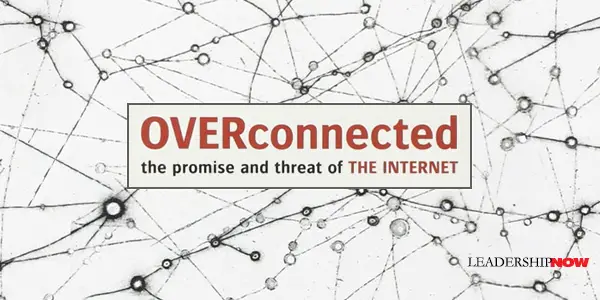
THE Internet is a technology and like any technology it can be a blessing or a curse depending on what you are doing with it. The Internet amplifies. This can be good or bad. Amplification means more connections and that means more crowd behavior. So what we are amplifying becomes an important question. To be used well, the Internet requires self-regulation—maturity. Unfortunately, we are not always good at that, so things can easily get out of control. The Internet is new and with most things new, maturity is not part of the equation. In Overconnected, Bill Davidow says that while the Internet didn’t cause the global economic crisis, it did act “as an accelerant, spreading information very quickly. It was gasoline on the flames. A crisis of this dimension would not have been possible without a very efficient, fast, cheap, and reliable information transportation system. Across the worldwide digital sprawl, things go viral at lightning speed. And people were carried away in competitive, greedy fervor of their own creation.” The Internet encourages extreme events.And of course the Internet affects us in other ways that really haven’t had time to process yet. We are not yet aware of how all of this is “affecting our institutions, our emotions, our judgment, and our levels of trust.” Overconnected has all the drama you’d expect from a book about the Internet—it’s a page-turner—but without the giddiness that makes so many of them so annoying. Davidow explains the dynamics of the Internet in clear terminology and great analogies. When a system cannot adjust to a certain threshold of connectivity, it becomes overconnected and unstable. In this state, either the environment or the institutions in it are unable to cope with the changes and become overwhelmed by cultural lag. Cultural lag means some element of the culture isn’t keeping up with all the changes around it creating the potential for confusion at best. For example, “in a highly connected environment, an investment bank can start conducting business differently and prosper as a result, then outrun the regulatory environment and spin out of control. If enough financial institutions do the same thing, the economy finds itself in an overconnected state, and chaos follows.” Davidow explains the key part of the overconnectivity issue: positive feedback. Not positive as in “good” but as in “give me more of the same.” So while a thermostat is an example of negative feedback as it regulates the temperature by saying “that heat was good, but we’ve had enough,” a malfunctioning thermostat would say, “Love the heat, just keep it coming” until it becomes extreme. The Internet has elements of both. Negative feedback creates transparency, but positive feedback drives overconnectivity. Positive feedback can create vulnerabilities. Davidow warns that we can expect more accidents and contagions. The compression of time that the Internet enables, allows for even more powerful positive feedback loops, “making predictions difficult and behavior fickle, while increasing the possibility of unexpected interactions.” In addition, “When accidents happen they can frequently trigger contagions, which in turn require high levels of connectivity to sustain themselves.” The solution, says Davidow, is to reduce the amount of positive feedback in the system, by weakening or even breaking interconnections. While he acknowledges that we have to get better at adapting to a world of our own making, he suggests that regulation and taxation of financial transactions, designing better systems with less positive feedback, and thereby building more slack into the system, would help. Overconnectivity helps to frame the issues cause you to think more deeply about the implications of the Internet. “This new environment,” he concludes, “is filled with opportunity, but whether we seize it or let it hold us hostage is our decision.” 
Posted by Michael McKinney at 11:53 PM
01.11.11

Robert Kennedy: The Mindless Menace of Violence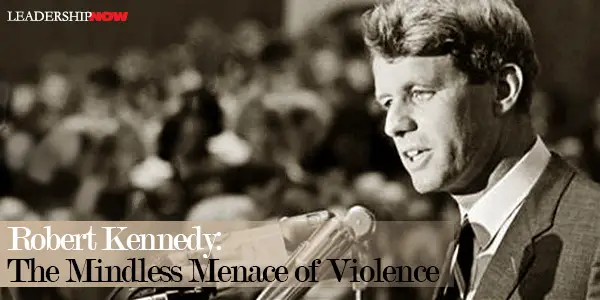
ON April 5, 1968, two months before his own death, Robert F. Kennedy gave a speech at the City Club of Cleveland in Cleveland, Ohio titled the "The Mindless Menace of Violence." For a nation trying to come to grips with the assassination of Martin Luther King Jr. the day before, Kennedy tried to frame the issues associated with violence. He reflected on wrong values and a society in which its citizens had become disconnected; people “with whom we share a city, but not a community.” This is a time of shame and sorrow. It is not a day for politics. I have saved this one opportunity, my only event of today, to speak briefly to you about the mindless menace of violence in America which again stains our land and every one of our lives. It is not the concern of any one race. The victims of the violence are black and white, rich and poor, young and old, famous and unknown. They are, most important of all, human beings whom other human beings loved and needed. No one - no matter where he lives or what he does - can be certain who will suffer from some senseless act of bloodshed. And yet it goes on and on and on in this country of ours. Why? What has violence ever accomplished? What has it ever created? No martyr's cause has ever been stilled by an assassin's bullet. No wrongs have ever been righted by riots and civil disorders. A sniper is only a coward, not a hero; and an uncontrolled, uncontrollable mob is only the voice of madness, not the voice of reason. Whenever any American's life is taken by another American unnecessarily - whether it is done in the name of the law or in the defiance of the law, by one man or a gang, in cold blood or in passion, in an attack of violence or in response to violence - whenever we tear at the fabric of the life which another man has painfully and clumsily woven for himself and his children, the whole nation is degraded. "Among free men," said Abraham Lincoln, "there can be no successful appeal from the ballot to the bullet; and those who take such appeal are sure to lose their cause and pay the costs." Yet we seemingly tolerate a rising level of violence that ignores our common humanity and our claims to civilization alike. We calmly accept newspaper reports of civilian slaughter in far-off lands. We glorify killing on movie and television screens and call it entertainment. We make it easy for men of all shades of sanity to acquire whatever weapons and ammunition they desire. Too often we honor swagger and bluster and wielders of force; too often we excuse those who are willing to build their own lives on the shattered dreams of others. Some Americans who preach non-violence abroad fail to practice it here at home. Some who accuse others of inciting riots have by their own conduct invited them. Some look for scapegoats, others look for conspiracies, but this much is clear: violence breeds violence, repression brings retaliation, and only a cleansing of our whole society can remove this sickness from our soul. For there is another kind of violence, slower but just as deadly destructive as the shot or the bomb in the night. This is the violence of institutions; indifference and inaction and slow decay. This is the violence that afflicts the poor, that poisons relations between men because their skin has different colors. This is the slow destruction of a child by hunger, and schools without books and homes without heat in the winter. This is the breaking of a man's spirit by denying him the chance to stand as a father and as a man among other men. And this too afflicts us all. I have not come here to propose a set of specific remedies nor is there a single set. For a broad and adequate outline we know what must be done. When you teach a man to hate and fear his brother, when you teach that he is a lesser man because of his color or his beliefs or the policies he pursues, when you teach that those who differ from you threaten your freedom or your job or your family, then you also learn to confront others not as fellow citizens but as enemies, to be met not with cooperation but with conquest; to be subjugated and mastered. We learn, at the last, to look at our brothers as aliens, men with whom we share a city, but not a community; men bound to us in common dwelling, but not in common effort. We learn to share only a common fear, only a common desire to retreat from each other, only a common impulse to meet disagreement with force. For all this, there are no final answers. Yet we know what we must do. It is to achieve true justice among our fellow citizens. The question is not what programs we should seek to enact. The question is whether we can find in our own midst and in our own hearts that leadership of humane purpose that will recognize the terrible truths of our existence. We must admit the vanity of our false distinctions among men and learn to find our own advancement in the search for the advancement of others. We must admit in ourselves that our own children's future cannot be built on the misfortunes of others. We must recognize that this short life can neither be ennobled or enriched by hatred or revenge. Our lives on this planet are too short and the work to be done too great to let this spirit flourish any longer in our land. Of course, we cannot vanquish it with a program, nor with a resolution. But we can perhaps remember, if only for a time, that those who live with us are our brothers, that they share with us the same short moment of life; that they seek, as do we, nothing but the chance to live out their lives in purpose and in happiness, winning what satisfaction and fulfillment they can. Surely, this bond of common faith, this bond of common goal, can begin to teach us something. Surely, we can learn, at least, to look at those around us as fellow men, and surely we can begin to work a little harder to bind up the wounds among us and to become in our own hearts brothers and countrymen once again.
Posted by Michael McKinney at 11:01 AM
01.10.11

The Power of Framing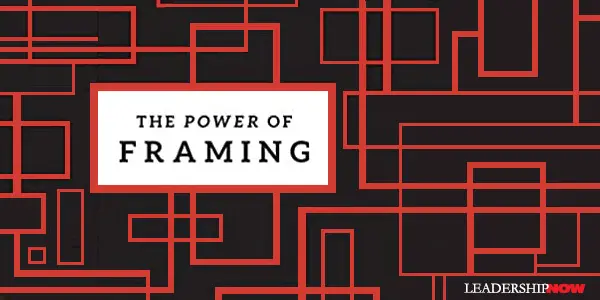
“Language becomes a key issue not just in our own sensemaking, but in how effectively we impact the sensemaking of others,” writes Gail Fairhurst. As leaders, we recognize that we cannot accomplish our objectives on our own, so this becomes important when we are trying to align the interests of others with our own. The Power of Framing by Gail Fairhurst is about understanding the meaning—the shared reality—created in our communication. Paraphrasing Michel Foucault, she writes, “people know what they say, and they usually know why they say what they say. What they do not understand is what they say does. The Power of Framing is an essential leadership book that will help us to understand the context-shaping features of our language so that we can then better manage the meaning of our communication. Recently, we have seen many examples of leaders creating unintended “realities” from the content of their communications alone that only served to make a big problem, bigger.People with the skills to communicate reality in a meaningful way often emerge as leaders, she observes. What we often fail to consider, is that when communicating, we are not just reacting to the environment; we actually shape or create it by how we interpret and talk about it. Being conscious of our framing then becomes critical. Self-awareness plays a major role in framing our communication to have the impact we intend. She begins by presenting six guiding rules for constructing reality: Rule 1: Control the Context. Leaders often cannot control events, but they can control the context under which events are seen if they recognize a framing opportunity. Rule 2: Define the Situation. At its most basic level, framing reality means defining “the situation here and now” in ways that connect with others. Rule 3: Apply Ethics. “Reality” is often contested. Framing a subject is an act of persuasion by leaders and imbued with ethical choices. Rule 4: Interpret Uncertainty. It is the uncertainty, confusion, and undecidability of “the situation here and now” that opens it up for interpretation and provides an opportunity for the more verbally skilled among us to emerge as leaders. Rule 5: Design the Response. Ultimately, leadership is a design problem. Leaders must figure out what leadership is in the context of what they do and, through framing and actions, persuade themselves and other people that they are doing it. Rule 6: Control Spontaneity. Effective framing requires that leaders be able to control their own spontaneous communications. With these rules in mind, Fairhurst explores framing as a skill that leaders must master to communicate vision and set priorities, a science that shows leaders how to think on their feet and frame on the spot, an art form that leaders must hone like a craft with story, metaphor, argument, and visual images as their primary tools, a set of emotions that leaders must deploy to complement their message and as an ethical response in order for leaders to achieve and maintain believability. As a science she explains the concept of priming for spontaneity. It’s more than just thinking through what you want to say in a given situation. It involves thinking through your mental models. She writes, “If you take the time to consciously and periodically think through your mental models as a leader, you are priming your unconscious to select and interpret new information using the models as a reference point.” What we say reflects our thinking and view of the world. Emotions are a part of leadership and emotional intelligence is required for framing. When emotions are running high you have an opportunity for framing. “Emotional regulation is a part of emotional intelligence, and two framing concepts play a role in this regard,” says Fairhurst. “Priming for spontaneity can assist in controlling one’s emotions in advance of a situation if one envisions a wide range of responses are likely to occur. Also, framing after the fact, or reframing, allows leaders to correct the emotionally charged messages they wish to modify.” In regards to ethics, she reminds us that “how we frame is a window into our ethics whenever we act in a leadership capacity.” This is closely tied to the concept of priming. We reflect and communicate our mental models in all that we do. To use in conjunction with this book, Fairhurst has created some valuable downloadable framing tools. There are links to additional resources for specific topics raised in each chapter, including films, documentaries, news clips and PowerPoint teaching slides. 
Posted by Michael McKinney at 11:52 AM
01.05.11

Insist on Heroes. And be One.
MAKING a difference requires a different kind of thinking. Making a difference means doing something different. To not be taken for granted means that you have to do things that are not expected—to step out of your comfort zone. Do more. Experience more. Serve more. A leader’s legacy doesn’t come easily. While a leader may be focused on tomorrow, that future will be based on what they do today. Some years ago, documentary filmmaker Ken Burns offered some advice for those starting out in life. The message applies to anyone who would lead and is worth reflecting on: Do something that will last and be beautiful. It doesn’t have to be a bridge—or a symphony or book or a business. It could be the look in the eye of a child you raise or in a simple garden you tend. But be on guard: do something that will last and be beautiful.
Posted by Michael McKinney at 09:58 PM
01.01.11

First Look: Leadership Books for January 2011Here's a look at some of the best leadership books to be released in January.




For bulk orders call 1-800-423-8273  Build your leadership library with these specials on over 160 titles. All titles are at least 40% off the list price and are available only in limited quantities. "The first thing naturally when one enters a scholar's study or library, is to look at his books. One gets the notion very speedily of his tastes and the range of his pursuits by a glance round his book-shelves." —Oliver Wendell Holmes (1809-1894), The Poet at the Breakfast Table. VIII.
Posted by Michael McKinney at 10:45 PM
|
BUILD YOUR KNOWLEDGE


How to Do Your Start-Up Right STRAIGHT TALK FOR START-UPS 
Grow Your Leadership Skills NEW AND UPCOMING LEADERSHIP BOOKS 
Leadership Minute BITE-SIZE CONCEPTS YOU CAN CHEW ON 
Classic Leadership Books BOOKS TO READ BEFORE YOU LEAD |
|